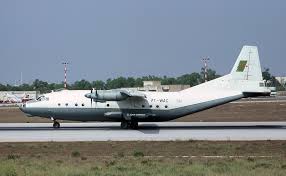Algerian Air Force- The most Powerful in Africa
- Garth Calitz
- Sep 15, 2020
- 4 min read

Algerian military aviation was created to support the fight of the People National Army against the French occupying forces. It came as part of the decisions of the Soummam congress held on 20 August 1956, which recommended a long-term plan to form a modern army. A structure was created to train future pilots. Many pilots were sent to friendly countries such as Egypt, Iraq, Syria, and the USSR, to train as aircraft pilots and aeronautics technicians.

During this initial period, the French colonial army started the lines of Challe and Morrice used to isolate the ALN fighters inside the country and to stop supplies coming from Tunisia and Morocco. The idea was born to train transport and helicopter pilots to ensure supplying the national liberation army, and in the process prepare the initial core of future military aviation.

Training was always one of the major preoccupations of the ALN/FLN leaders and b when independence was achieved military aviation had a core of pilots and technicians who laid the foundations of the present Air Force. The air force branch was born and the first air force units were set up a flight of helicopters that was acquired during the revolution, and a flight of combat aircraft.

The Algerians authorities continued to send trainees to friendly countries while waiting for the creation of Algerian Air Force training facilities. In 1966, the Air Base of Tafraoui in the 2nd Military Region was built as an air officers' school (EOA) where the first officer students were to train as pilots and technicians in aeronautics.

During this first decade, immediately after independence, the Algerian Air Force acquired MiG-15UTI and MiG-17’s from the USSR and Egypt. The Algerian government decided to enhance the capabilities of the army and the air force when border clashes with Morocco occurred in 1963. MiG-17F light bomber, MiG-21 F13 interceptor, Su-7BMK fighter/bomber, An-12 Airlifters were purchased from the USSR as well a number of Mi-1 and Mi-4 helicopters. During the Six-Day War and War of Attrition between 1967 and 1973, two squadrons of MiG-17F, one squadron of MiG-21F13, and one squadron of Su-7BMK were stationed in Egypt to support the Arab coalition.
Later during the Yom Kippur War, the Algerian Air Force participated in the conflict under the unified Egyptian military command. MiG-21F-13s and newer MiG-21PFs were mainly used to protect the Cairo region. MiG-17F and Su-7BMK aircraft also participated in the war, generally deployed in strafing and bombing missions. In October 1973 two Su-7BMKs, one MiG-21 and a number of MiG-17Fs were shot down by Israel.
In 1976, Algerian Air Force planes returned from Egypt to their home bases in Algeria. Shortly after dozens of MiG-23MF, MiG-23BN and MiG-25P were acquired and entered in the inventory. The ageing fleet of MiG-21F-13s and MiG-21PFs were replaced by higher-performance MiG-21MF and later MiG-21Bi interceptors.
The High Command dissociated the Air Defence of the territory from the Department of the Air Force, which was built in 1986 as an air force command. A central command assisted by a general staff and an inspectorate, an arms division, a department of support and specialized offices for Air bases, schools, training centres, support institutions, equipment renovation enterprises and defence, and control units.
During this uncertain period, few changes occurred in the combat aircraft inventory of the Algerian Air Force. Ten Su-24MKs were received from the USSR, while the MiG-17F was phased out. A new aircraft supplier emerged just after the Iranian revolution when Algeria received eighteen C-130H Hercules, twelve T-34 Mentors, and twelve Hawker Beechcraft King Airs supplied by USA from 1981 to 1989, for transport and training purposes.
The Air Force purchased a large number of MiG-29s from Belarus and Ukraine from 1999 to 2003. At least twenty-five Su-24MKs were also acquired during the same period. After the large military deal concluded with Russia during March 2006, Algeria ordered twenty-eight Su-30MKAs, sixteen Yak-130As, and thirty-four MiG-29SMTs.
In 2008, the MiG-29 SMT contract was cancelled and the delivered aircraft were returned to Russia and exchanged for sixteen Su-30MKA multi-role fighters. While the current front-line fleet primarily consists of Russian-origin aircraft such as the Sukhoi Su-30 and the MiG-29, Algeria has expressed an interest in acquiring aircraft from China. Algeria has been seen as a potential operator of the Chinese 4th-Generation JF-17 Thunder fighter project.

The Algerian Air Force has announced the signing of a contract for the acquisition of fourteen Su-57 stealth fighters and becomes the first customer to whom Sukhoi will export this more advanced Russian fighter.

The Algerian air force has also signed two other contracts for fourteen Su-34 bombers and fourteen Su-35 air domination aircraft. An option for two other squadrons of fourteen aircraft for each type of aircraft was also signed to compensate for the natural withdrawal of aircraft from the Air Force fleet in the near future.

The air force has two regiments of Fusiliers Commandos de l'Air, primarily base defence troops which have reportedly taken part in anti-terrorism operations. They are the 772nd and 782nd Regiment des Fusiliers Commandos de l'air (RFCA).
With the Algerian Air Forces current inventory of over 14,000 personnel and 750 aircraft there is no doubt that they are the most powerful Air Force on the African continent and on the arrival of all the ordered aircraft this position will be further strengthened.




























































Comments